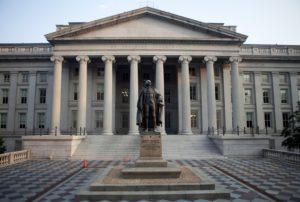U.S. Bailout From Last Recession Lives on as Downturn Risks Rise

TARP, the U.S. government bailout program born of the financial crisis a decade ago, lives on today as economists warn of a new recession.
Congress authorized the Troubled Asset Relief Program in late 2008 to stabilize the financial system with up to $700 billion — later reduced to $475 billion. To date, about $450 billion in taxpayer money has been committed, either lent or directly invested under TARP to banks and corporations, according to Treasury Department data.
Today, a Bloomberg survey of economists puts the likelihood of a new recession at 25 percent in the next 12 months — a six-year high. Economists cite mounting dangers, including the trade war with China and the partial shutdown of the federal government.
During the financial crisis, TARP’s Automotive Industry Financing Program helped auto finance companies and automakers General Motors and Chrysler to the tune of $79.7 billion and the U.S. has recovered all but about $12 billion of the bailout money, the Treasury data show.
TARP’s support program has been shrunk considerably, but the Capital Purchase Program still has three banks with outstanding balances of an aggregate $22.8 million. A total of $3.3 billion in losses were realized by 34 banks, most recently, OneFinancial Corporation in August and Cecil Bancorp in late June.
More than 80 percent of the government’s losses came in November 2009 when CIT Group and UCBH Holding entered bankruptcy and $2.3 billion and $299 million was written off, respectively.
Eight firms that participated in TARP’s Community Development Capital Initiative continue to have $29.3 million outstanding. The program has been a boon to financial agents and legal firms with $1.4 billion in compensation paid through the end of 2018.
Among those participating, according to the Treasury, are The Bank of New York Mellon, Alliance Bernstein, L.P., Morgan Stanley, Lazard Fréres, Perella Weinberg Partners and law firms including Venable, Perkins Coie and Hughes Hubbard & Reed.
— Alex Tanzi (Bloomberg)
















